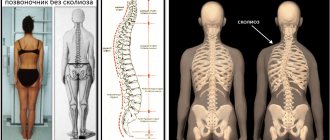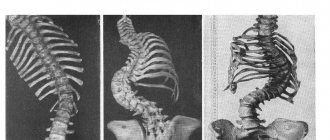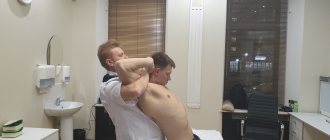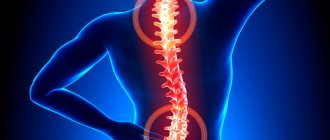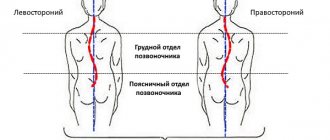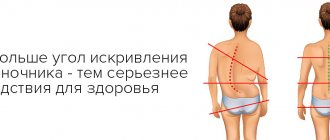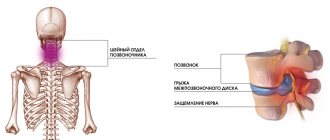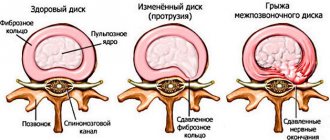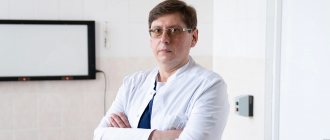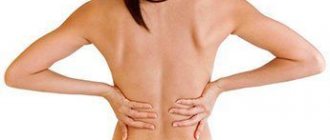Pediatric neurologist
Stepanenko
Natalya Leonidovna
31 years of experience
Neurologist, member of the Moscow Neurological Society
Make an appointment
If the spine is curved sideways along its axis, a specialist can diagnose scoliosis. It is important to make a timely diagnosis and begin treatment, because all parts of the spine are involved in this process, which will lead to twisting as the disease progresses. To make a diagnosis, the doctor conducts an external examination and prescribes a series of medical tests, the main of which is radiography.
If the doctor has diagnosed the initial degree of curvature, it is recommended to begin treatment immediately, because thoracic scoliosis is a progressive disease that over time leads to deformation of the entire spinal column, to increased physiological curvature. As the disease develops, the entire body suffers, the position of the chest and pelvis changes, and many organs fail.
The most dangerous periods are periods of intensive growth; these include age categories from 4 to 6 years and from 10 to 14 years. Experts recommend paying great attention to the time of puberty, because at this time the spine is most subject to deformation (for boys - 11 to 14 years old, for girls - 10 to 13 years old). But this is only provided that a small deviation (no more than 10˚) has already been confirmed before this period.
Parents often confuse concepts such as scoliosis and poor posture. These are two different things, scoliosis of the back is a more serious disease and do not forget that it is progressive, requiring more careful attention from both the patient (or parents, if the disease develops in a child) and the doctor. You also need to understand that poor posture can be corrected by physical exercise, but scoliosis requires a different approach.
Symptoms and signs
At the initial stage of development, the disease can be determined only by external signs; it does not show any symptoms. If parents notice that when their child stands, one shoulder is lowered, then they should immediately make an appointment with a specialist.
External signs also include the following symptoms:
- distance between waist and arm;
- asymmetrical arrangement of the blades;
- When bending forward, the curvature of the spine is noticeable.
Scoliosis can be left-sided or right-sided. Chaklin proposed a classification used in Russia. It is based on X-ray indicators and clinical signs, based on which four degrees of disease development can be distinguished:
- 1st degree scoliosis has a curvature angle of 10˚, symptoms: shoulder girdles of different heights, asymmetrical waist, stoop;
- scoliosis 2nd degree – angle of curvature from 11-25˚, symptoms: half of the pelvis is curved, a muscle roll forms in the lumbar region, protrusion in the thoracic region;
- scoliosis 3rd degree – curvature angle 26-50˚, symptoms: weakened abdominal muscles, sinking ribs, appearance of a hump and symptoms of the first two stages;
- Scoliosis 4 degrees – curvature angle from 50˚, symptoms: hump, muscle strain, severe spinal deformity.
Already at the first stage of manifestation of scoliosis symptoms, you need to contact a specialist who will choose the right treatment. JSC "Medicine" (clinic of academician Roitberg) is located in the center of Moscow: 2nd Tverskoy-Yamskaya lane, 10.
Are you experiencing symptoms of scoliosis?
Only a doctor can accurately diagnose the disease. Don't delay your consultation - call
Massage
One of the very effective ways to prevent scoliosis is massage. It is recommended by pediatricians for the baby, starting from early infancy. Even newborn babies are given a light massage of the legs, arms and other parts of the body.
The key factor in the prevention of scoliosis through massage is the impact on the muscular corset through special movements. When carrying out such a procedure, you can restore the symmetry of muscle tissue, improve microcirculation of blood in the spinal column and get rid of unpleasant sensations and discomfort.
Back massage can also be performed at home. First, with light, gentle movements, stroking and rubbing the neck is performed. Next you need to smoothly lower yourself to the lumbar region. This prepares all muscles for the procedure and deeper effects.
Causes
Thoracic scoliosis begins to develop in childhood and adolescence. The most common is idiopathic, the cause of its development cannot be determined. Among the total number of cases, this type of scoliosis accounts for 80%. Girls are mostly at risk; they are more likely to develop the disease than boys.
Also, the cause of scoliosis (20% of cases) is congenital deformity of the spine. Among the causes are diseases of connective tissues, severe injuries, amputation of limbs, different lengths of limbs.
The principle of treatment of scoliosis in adults
The formation of the skeleton in men is completed at 25 years of age, and in women at 20. It is not surprising that scoliosis found in patients 30-40 years of age cannot be cured . All that can be done at this stage is to get rid of the manifestations of the disease.
To eliminate scoliosis after the completion of the formation of the scoliotic arch, measures are taken aimed at:
- reduction of spinal curvature;
- normalization of bone structure;
- restoration of vertebral mobility;
- improved blood circulation;
- eliminating pain in the back area;
- strengthening the muscle corset.
When to see a doctor
It is important for parents to monitor the development and health of the child and regularly have him examined by an orthopedist. If parents notice that when their child stands with one shoulder higher than the other, they should consult a doctor. Take into account! The initial stage of development passes without symptoms, the angle of deviation is small, only a qualified specialist can notice the pathology.
Also, if a child has congenital defects, for example, different leg lengths, this may affect the development of the disease, so an appointment with a doctor is required. Timely treatment will help avoid surgical intervention. At JSC “Medicine” (academician Roitberg’s clinic) you can make an appointment with experienced doctors with extensive experience. The best traumatologists and orthopedists work here. The clinic is located at 2nd Tverskoy-Yamskaya lane 10.
Prevention of scoliosis in adults
Prevention of scoliosis includes:
- Maintaining an active lifestyle . If you have scoliosis or prerequisites for its development, you need to keep yourself in good physical shape, because with weakened muscles, the curvature can progress. At the same time, it is better to avoid excessive loads.
- Change of professional activity . There are professions that more often than others lead to the development of scoliosis. Thus, people with poor posture should avoid professional sports, as well as work as builders, drivers and loaders. Sedentary work can also aggravate the curvature, so office workers should walk more and take breaks every 30 minutes.
- Proper nutrition . Overeating negatively affects the functioning of internal organs and puts stress on the spinal column. In addition, it leads to the development of obesity, which can aggravate the existing curvature. As for the diet itself, it should be balanced in carbohydrates, fats and proteins. Vegetarians, whose diet contains insufficient proteins, which are responsible for the development of muscle mass and bone strength, should review their menu first of all.
Video: “Manual therapy for scoliosis”
Diagnostics
By contacting JSC “Medicine” (academician Roitberg’s clinic), patients will be able to undergo a full examination. Innovative equipment is presented here, doctors use modern techniques. Diagnosis of the disease takes place in several stages. The first is a physical examination. The doctor examines the patient in several positions: standing, lying, sitting. When the patient is standing, the doctor pays attention not only to the spine and asymmetry, but also measures the length of the legs, which helps to understand whether there are differences in the indicators or not.
The specialist also checks how mobile the lower back is, at what level the shoulders and shoulder blades are, and their symmetry. During the examination, the doctor examines the chest, abdomen, lower back, and pelvis. When the patient is sitting, the doctor measures the length of the spine, looks at how noticeable the curvature of the spine is from the side, and how the pelvis is located in different poses of the limbs.
While the patient is lying down, the specialist will determine the level of curvature of the spinal arch and examine the abdomen to understand how weakened the muscles are. The second stage of diagnosis is x-ray. If a doctor has diagnosed scoliosis of the spine, X-rays should be taken at least twice a year. The first x-ray is taken in a standing position, then in different positions with moderate stretching of the spine, which allows you to fully assess the situation and determine the level of deformation. After the image, the doctor will determine the angle of curvature.
The third stage is instrumental. If the disease progresses rapidly, it is impossible to frequently take x-rays, because with each image the patient receives a dose of radiation. To avoid this and obtain new information about the development of the disease, clinic specialists use ultrasound. In some cases, the patient is prescribed an MRI. The clinic practices an individual approach, the patient’s complaints are taken into account, the doctor will give advice, clarifications, and answer questions.
Complications
Curvature of the lumbar spine can lead to deformation of the chest as it progresses. The organs of the abdominal and thoracic cavities can change their position, which is why the entire body ceases to function correctly. This is accompanied by a pronounced cosmetic defect.
Progressive disease leads to:
- to a decrease in pulmonary function, as well as ventilation failure;
- the occurrence of right ventricular failure, manifested in fainting, chest pain, shortness of breath;
- prolapse of the kidneys and liver, disruption of their function;
- dystrophic changes in intervertebral discs;
- severe spinal disorders up to paralysis, problems with the functioning of blood and lymph circulation are possible.
All these factors gradually lead to exhaustion of the body, which can result in disability.
Treatment
The doctors of the clinic are well versed in pathology and have extensive experience; treatment of scoliosis in adults is carried out under the supervision of a qualified specialist. The doctor’s task is to determine the angle of curvature of the spine, how quickly the disease progresses, and how much internal organs are damaged. If necessary, the orthopedic traumatologist refers the patient to other specialists, for example, to a cardiologist or pulmonologist.
In order to choose a treatment method, you need to understand what caused the development of the disease, how severe it is, how it progresses, what its nature is, and what degree of the disease it is. Only after this will the doctor understand how to cure scoliosis.
Scoliosis can be treated either conservatively or surgically. Conservative methods are used if the disease was caused by an injury or shortening of a limb. By understanding and eliminating the cause, you can get rid of scoliosis. For example, the cause was different lengths of the limbs; to correct it, the doctor may suggest wearing special shoes or using special insoles. The conservative method involves special exercises for scoliosis, physical therapy, and gymnastics. At JSC “Medicine” (clinic of academician Roitberg), a set of exercises is selected individually for each patient.
If the angle of curvature is up to 15˚, then gymnastics helps correct the situation; if the angle of curvature is more than 15˚, but does not exceed 20˚, the patient is prescribed to wear a corset. The frequency and time of wearing a corset is determined individually, based on the situation, for example, it can only be at night, or it can be both night and day. The duration (six months or more) is also determined individually.
If the angle of curvature is within 20-40˚, the patient is admitted to the hospital.
If conservative methods do not stop the progression of the disease, and the angle of curvature reaches 45˚, surgical intervention is prescribed. During the operation, the spine is aligned to a certain angle and fixed using special metal structures.
Gymnastic exercises
Therapeutic exercises are considered the most effective way to prevent various types of spinal deformities. With the help of a properly selected set of exercises, you can achieve restoration of the symmetrical position of the back muscle corset.
Among the most effective types of exercises are:
- performing circular movements of the shoulder girdle;
- circular movements with bent elbows;
- squats while pressing tightly against the wall;
- the so-called “bicycle” - circular movements of the legs that resemble riding a bicycle;
- lying on the floor, swinging your legs to the right, left and cross, while you need to slightly raise your torso;
- stretch your arms up, and then throw them back, one at the top and the other at the bottom, try to reach each other;
- try to bring your shoulder blades towards each other, straining them, then relax and straighten them to their original position.
If a person feels discomfort while performing therapeutic exercises, do not stop. With systematic exercise, discomfort and unpleasant sensations usually go away quickly. Such gymnastics makes it possible to get rid of deformation and prevent its development.
